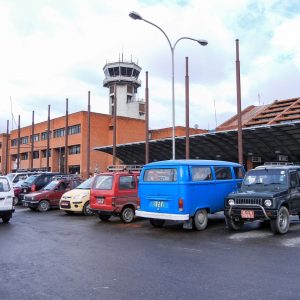Nestled in the heart of the Kathmandu Valley, amidst the majestic peaks of the Himalayas, lies an essential gateway to the enchanting land of Nepal – Tribhuvan International Airport. As the sole international airport serving Nepal, it not only connects the country to the world but also serves as a symbolic entry point to a land steeped in history, culture, and natural beauty.
A Brief History:
Named after King Tribhuvan Bir Bikram Shah, the airport holds significant historical importance for Nepal. Established in 1949, it began as a simple airfield and has since evolved into the primary hub for domestic and international air travel in the country. Over the years, it has witnessed substantial growth and development to accommodate the increasing influx of tourists and passengers.
Architectural Marvel:
While Tribhuvan International Airport may not boast the modern grandeur of some of the world’s largest airports, its charm lies in its simplicity and functionality. The architecture reflects Nepal’s cultural heritage, with elements inspired by traditional Nepali design. From the intricately carved wooden beams to the pagoda-style roofs, every detail exudes a sense of warmth and welcome.
Gateway to the Himalayas:
For many travelers, Tribhuvan International Airport marks the beginning of an unforgettable journey into the Himalayas. From here, adventurers set off to conquer the world’s tallest peaks, including Mount Everest. The airport serves as a vital logistics hub for mountaineering expeditions, providing essential supplies, equipment, and transportation to remote mountain regions.
Tribhuvan International Airport serves as the primary gateway for adventurers embarking on journeys into the majestic Himalayas. As travelers step off the plane and onto Nepali soil, they are greeted by the awe-inspiring sight of snow-capped peaks towering in the distance, setting the stage for unforgettable adventures.
For mountaineers and trekkers, the airport is the starting point for expeditions to some of the world’s highest peaks, including the legendary Mount Everest. From here, they embark on epic quests to conquer summits, navigate rugged trails, and immerse themselves in the breathtaking beauty of the Himalayan landscape.
The airport plays a crucial role in supporting these adventures, serving as a logistical hub for mountaineering expeditions. Supplies, equipment, and provisions are flown in to support climbers as they ascend to dizzying heights. Helicopters shuttle climbers and their gear to base camps, providing vital assistance in remote mountain regions.
Beyond mountaineering, Tribhuvan International Airport also facilitates access to the diverse cultural and natural attractions of the Himalayan region. Travelers eager to explore ancient temples, serene monasteries, and vibrant mountain villages use the airport as a launching pad for their journeys.
As visitors pass through the airport’s gates, they are not just embarking on a physical journey; they are entering a realm of spiritual and cultural significance. The Himalayas, with their towering peaks and spiritual resonance, have long captured the imagination of adventurers and seekers alike. Tribhuvan International Airport, with its strategic location at the foot of these legendary mountains, serves as the gateway to a world of exploration, discovery, and transformation.

Cultural Melting Pot:
Tribhuvan International Airport serves as a vibrant hub where travelers from diverse backgrounds converge, creating a dynamic atmosphere of cultural exchange. Here, passengers from all corners of the globe mingle amidst the hustle and bustle of arrivals and departures, forging connections and sharing experiences that transcend linguistic and cultural barriers.
The airport’s bustling terminals offer a kaleidoscope of languages, attire, and customs, reflecting the rich tapestry of global cultures. Conversations in various tongues fill the air, as travelers swap stories of their adventures and discoveries. Whether it’s bonding over a shared love for adventure or exchanging tips on navigating the streets of Kathmandu, every interaction adds a unique flavor to the airport experience.
In addition to verbal exchanges, the airport’s eateries provide an opportunity to savor the flavors of Nepal and beyond. From traditional Nepali delicacies to international cuisine, there’s something to suit every palate. As travelers sample local specialties or indulge in familiar comfort foods, they embark on a culinary journey that mirrors the diversity of the world outside.
Beyond the terminals, cultural displays and performances offer glimpses into Nepal’s rich heritage, captivating audiences with traditional music, dance, and art. These showcases not only entertain but also educate, providing insights into the country’s history and traditions.
In this melting pot of cultures, stereotypes are shattered, and friendships are forged. Whether it’s a brief exchange of smiles with a fellow traveler or a deep conversation that transcends language barriers, every interaction fosters a sense of unity and understanding. Tribhuvan International Airport, with its diverse array of passengers and experiences, embodies the beauty of cultural diversity and the universal language of human connection.
Challenges and Future Prospects of Tribhuvan International Airport:
Despite its significance, Tribhuvan International Airport faces challenges typical of airports in developing countries. Limited infrastructure and resources often result in congestion and delays, especially during peak travel seasons. However, the Nepalese government and airport authorities are actively working to address these issues through expansion projects and modernization efforts.
Looking ahead, the future of Tribhuvan International Airport appears promising. Plans for a new international terminal and runway expansion aim to enhance capacity and efficiency, ensuring a seamless travel experience for passengers. Additionally, initiatives to improve air traffic management and safety standards underscore Nepal’s commitment to elevating its aviation sector to international standards.
Tribhuvan International Airport faces several challenges stemming from its rapid growth and limited infrastructure. These challenges include congestion, delays, and the need for modernization to meet international standards. However, amidst these obstacles lie promising opportunities for improvement and expansion.
Challenges:
- Infrastructure Limitations: The airport’s infrastructure struggles to cope with the increasing volume of passengers and flights, leading to congestion and delays, especially during peak travel seasons.
- Safety Concerns: Aging infrastructure and limited resources pose safety challenges, necessitating upgrades to meet international safety standards and ensure the well-being of passengers and staff.
- Operational Efficiency: Inefficient operational practices contribute to delays and disruptions, impacting the overall passenger experience and the airport’s reputation.
Future Prospects:
- Expansion Projects: The Nepalese government and airport authorities have initiated expansion projects aimed at enhancing capacity and efficiency. Plans for a new international terminal and runway expansion are underway to accommodate the growing demand for air travel.
- Modernization Efforts: Investments in modernizing airport facilities and technology are essential to improve operational efficiency and enhance the passenger experience. Upgrades to air traffic management systems, baggage handling processes, and passenger amenities will contribute to a smoother and more seamless travel experience.
- Safety and Security Enhancements: Enhancing safety and security measures is a priority to ensure the well-being of passengers and staff. Investments in advanced security screening technologies, fire suppression systems, and emergency response capabilities will bolster the airport’s resilience and preparedness.
- Collaboration with Stakeholders: Collaboration with airlines, regulatory agencies, and other stakeholders is crucial for implementing effective solutions to the airport’s challenges. By fostering partnerships and communication, the airport can streamline operations, optimize resources, and address issues in a coordinated manner.
In conclusion, while Tribhuvan International Airport faces challenges in its quest for growth and modernization, the future holds promising opportunities for improvement. Through strategic investments, collaboration with stakeholders, and a commitment to meeting international standards, the airport can overcome its challenges and emerge as a world-class aviation hub, serving as a vital gateway to the enchanting land of Nepal.
Conclusion:
Tribhuvan International Airport stands as more than just a transit point; it is a symbol of Nepal’s connection to the world and a gateway to its unparalleled natural beauty and rich cultural heritage. As travelers pass through its halls, they become part of a shared journey that transcends borders and celebrates the universal spirit of exploration and discovery. Whether embarking on a trek into the Himalayas or immersing oneself in the vibrant streets of Kathmandu, the journey begins here, at Tribhuvan International Airport.
Please Follow Us For more Updates :

